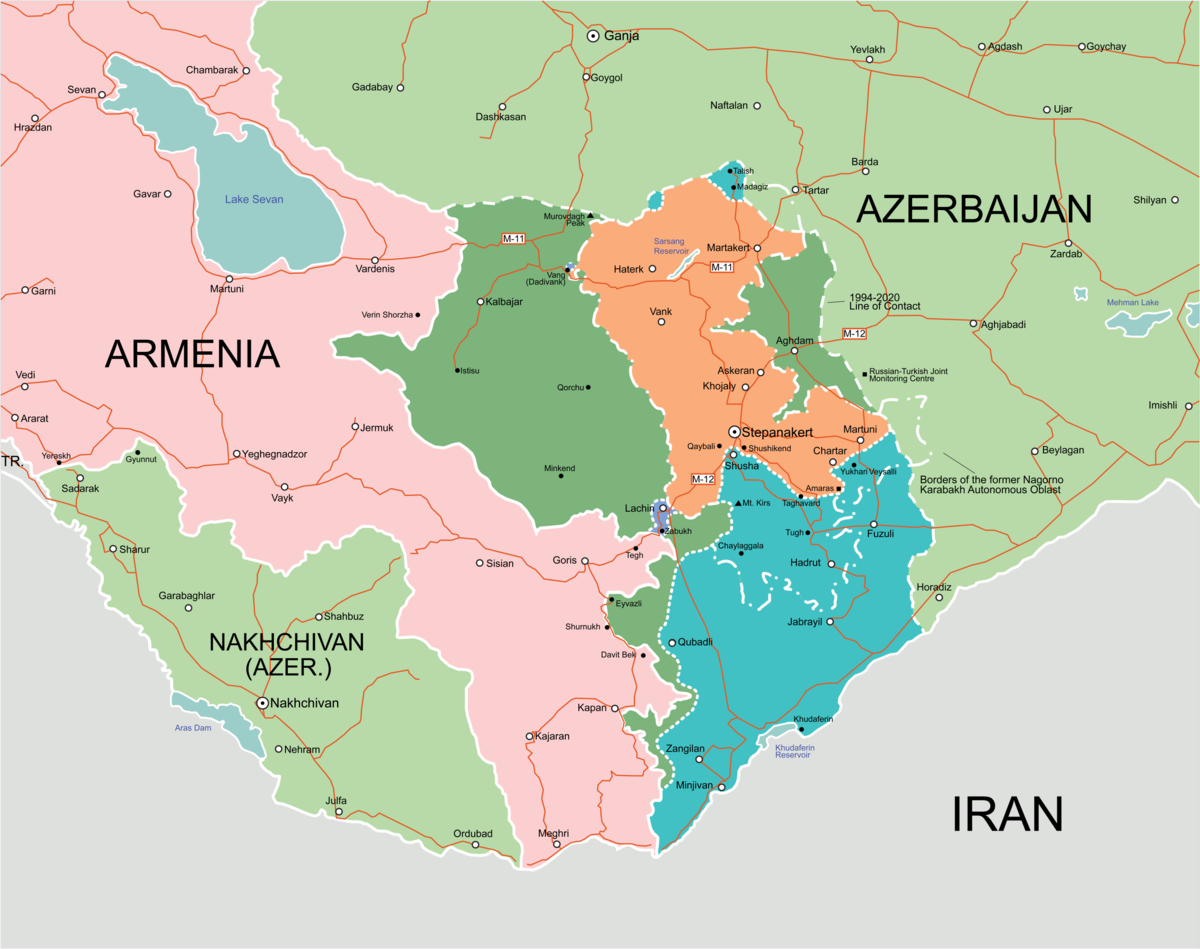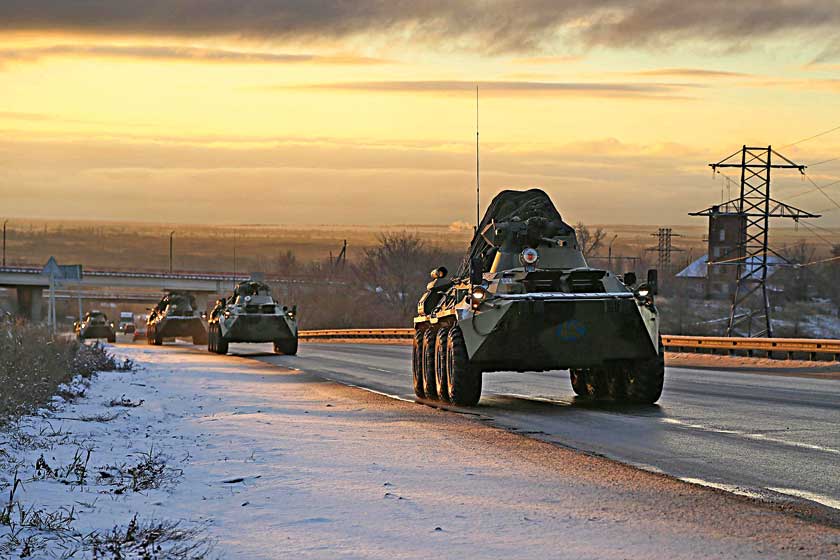
War in Nagorno-Karabakh part 3

Wheeled combat vehicles BTR-82A of the 15th separate mechanized brigade of the RF Armed Forces are heading towards Stepanakert. According to the tripartite agreement, Russian peacekeeping forces will now guarantee stability in Nagorno-Karabakh.
The 44-day conflict, known today as the Second Karabakh War, ended on November 9-10 with the conclusion of an agreement and the virtual surrender of the Karabakh Defense Army. The Armenians were defeated, which immediately turned into a political crisis in Yerevan, and Russian peacekeepers entered the territorially reduced Nagorno-Karabakh / Archach. In the reckoning of rulers and generals, typical after each defeat, the question arises, what were the reasons for the defeat of the troops defending Arkah?
At the turn of October and November, the Azerbaijani offensive developed in three main directions - Lachin (Laçın), Shusha (Şuşa) and Martuni (Xocavnd). The advancing elements of the Azerbaijani armed forces were now attacking the forested mountain ranges, where it became critical to control the successive highlands that rise above the cities and roads. Using infantry (including special units), air superiority and artillery firepower, they successively took over the area, especially in the Shushi area. The Armenians set up ambushes with the fire of their own infantry and artillery, but supplies and ammunition were running out. The Karabakh Defense Army was defeated, almost all heavy equipment was lost - tanks, infantry fighting vehicles, armored personnel carriers, artillery, especially rocket artillery. Moral problems became more and more serious, supply problems (ammunition, provisions, medicines) were felt, but most of all the loss of life was enormous. The list of dead Armenian soldiers published so far turned out to be incomplete when the missing, in fact, killed soldiers, officers and volunteers were added, whose bodies were lying in the forests around Shushi or in the territory occupied by the enemy. to that. According to the report dated December 3, probably still incomplete, the losses of the Armenians amounted to 2718 people. Taking into account how many bodies of dead soldiers are still being found, it can be assumed that irretrievable losses could be even greater, even in the order of 6000-8000 killed. In turn, the losses on the Azerbaijani side, according to the Ministry of Defense on December 3, amounted to 2783 killed and more than 100 missing. As for civilians, 94 people were to die and more than 400 were injured.
Armenian propaganda and the Nagorno-Karabakh Republic itself acted until the last moment, assuming that control over the situation was not lost ...

An Armenian infantry fighting vehicle BMP-2 was damaged and abandoned on the streets of Shushi.
Recent clashes
When it turned out that in the first week of November, the Karabakh Defense Army had to reach for the last reserves - volunteer detachments and a massive movement of reservists, this was hidden from the public. All the more shocking in Armenia was the information that on November 9-10 a trilateral agreement with the participation of the Russian Federation on the cessation of hostilities was developed. The key, as it turned out, was the defeat in the Shushi region.
The Azerbaijani attack on Lachin was finally stopped. The reasons for this are unclear. Was this influenced by the Armenian resistance in this direction (for example, the still heavy artillery shelling) or the exposure to possible counterattacks of the left flank of the Azerbaijani troops advancing along the border with Armenia? There were already Russian posts along the border, it is possible that sporadic shelling was carried out from the territory of Armenia. In any case, the direction of the main attack shifted to the east, where the Azerbaijani infantry units moved across the mountain range from Hadrut to Shusha. The fighters operated in small units, isolated from the main forces, with light support weapons on their backs, including mortars. Having traveled about 40 km through the wilderness, these units reached the outskirts of Shushi.
On the morning of November 4, an Azerbaijani infantry unit entered the Lachin-Shusha road, effectively preventing its use by the defenders. Local counterattacks could not push back the Azerbaijani infantry that had approached Shusha itself. Azerbaijani light infantry, bypassing the Armenian positions, crossed the deserted mountain range south of the city and suddenly found themselves right at its foot. The battles for Shusha were short-lived, the Azerbaijani vanguard threatened Stepanakert, which was not ready to defend itself.
The multi-day battle for Shusha turned out to be the last major clash of the war, in which Arch's forces exhausted the remaining, now small, reserves. Volunteer units and the remnants of regular army units were thrown into the battle, the losses in manpower were huge. Hundreds of bodies of killed Armenian soldiers were found in the Shushi region alone. The footage shows that the defenders gathered no more than the equivalent of an armored company battle group - in just a few days of battle, only a few serviceable tanks were identified from the Armenian side. Although the Azerbaijani infantry fought alone in places, without the support of their own combat vehicles left in the rear, there was nowhere to effectively stop them.
In fact, Shusha was lost on November 7, the Armenian counterattacks failed, and the vanguard of the Azerbaijani infantry began to approach the outskirts of Stepanakert. The loss of Shusha turned an operational crisis into a strategic one - due to the advantage of the enemy, the loss of the capital of Nagorno-Karabakh was a matter of hours, maximum days, and the road from Armenia to Karabakh, through Goris-Lachin-Shusha-Stepanakert, was cut off.
It is worth noting that Shusha was captured by the Azerbaijani infantry from the special forces units trained in Turkey, intended for independent operations in the forest and mountainous terrain. The Azerbaijani infantry bypassed the fortified Armenian positions, attacked in unexpected places, set up ambushes.